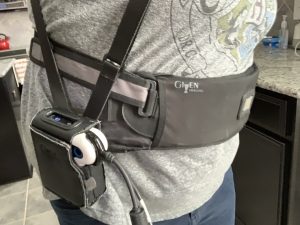Third in a series. Read part one and two.
In previous columns, I looked at upper endoscopies and colonoscopies and why these procedures are carried out. In this column, I will discuss the third type of endoscopy: the small intestine capsule endoscopy.
What is a capsule endoscopy?
A capsule endoscopy — also known as a pill camera endoscopy — allows your doctor to get a good view of your small intestine. Upper endoscopies are carried out to view the upper gastrointestinal tract, from the mouth to the beginning of the small intestine. A colonoscopy looks at the rectum, sigmoid, and colon. It can be challenging to get a clear view of the small intestine.
For this test, you swallow a pill with a tiny wireless camera inside it. As the pill moves along your digestive tract, the camera captures images that are transmitted to a device you wear. Your doctor can then download the images to a computer and compose a virtual endoscopy video.
Preparing for the capsule endoscopy
The prep for the pill camera endoscopy is more straightforward than that of the colonoscopy and similar to the upper endoscopy. Typically, around noon the day before the procedure, you are asked to switch to a clear liquid diet, which includes water, juice, clear sodas, broths, and jello. After midnight, you’re restricted to water only. You must stop all fluids a specified number of hours before you swallow the pill camera. You may be asked to take a mild laxative the night before — but don’t worry, it’s not a bowel clear-out!
Starting the endoscopy
At your doctor’s office, a pill camera, sensor belt, and data recorder will be ready for you. Swallowing the pill camera is easy as it’s similar in size to a vitamin tablet. Having taken the pill, you are fitted with a sensor belt that connects to a recording drive that you wear in a shoulder strap.

What you can and can’t do during the procedure
Staying active helps your doctor to get good quality images from the camera traveling along your digestive tract. You will be asked to remain upright and to walk around, and to avoid lying down. However, although your doctor wants you to move around, it’s not a good idea to engage in exercise while you’re wearing the sensor belt.
During the endoscopy, you should stay away from X-ray, CT scan, and MRI machines because they can interfere with the transmissions of images. MRI equipment is particularly problematic because it uses strong magnetic fields that could cause internal damage.
Risks associated with capsule endoscopy
The procedure is low-risk; however, on rare occasions, the camera can become lodged in the intestines of those who have had surgeries or a narrowing of their intestines known as strictures. If this happens, your doctor will remove the pill camera by scope (if reachable) or by laparoscopic surgery.
If your doctor has concerns about lodging, he or she can conduct a trial test. Your doctor will have you swallow a “dummy pill” and order an X-ray for 36 hours later to see where the pill is located. If it’s in the colon, then you’ll likely be given the all-clear for the test. If the pill is still in the small intestine, your doctor will order another X-ray the following day. If the dummy pill becomes stuck in one area, this is an indication that you should not have the pill camera test. The “dummy pill” is biodegradable and will be passed on its own.
Following completion of the test
The test lasts about eight hours. A recording device will alarm to let you know the test has concluded. You can return the equipment to your doctor’s office and resume your normal diet. It takes about two days for your doctor to call with the results. It takes one to two days for the pill camera to make it through your entire digestive tract and you will pass the camera through your stool.
Disclaimer: Doctors do not want the pill camera returned as they’re not reusable.
***
Note: IBD News Today is strictly a news and information website about the disease. It does not provide medical advice, diagnosis, or treatment. This content is not intended to be a substitute for professional medical advice, diagnosis, or treatment. Always seek the advice of your physician or other qualified health providers with any questions you may have regarding a medical condition. Never disregard professional medical advice or delay in seeking it because of something you have read on this website. The opinions expressed in this column are not those of IBD News Today, or its parent company, BioNews Services, and are intended to spark discussion about issues pertaining to IBD.

